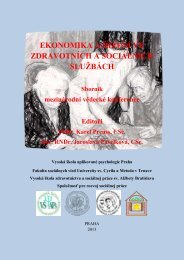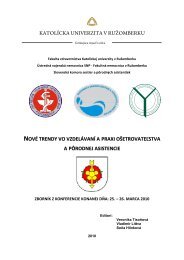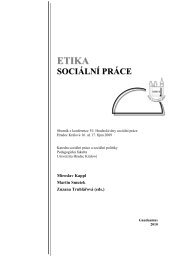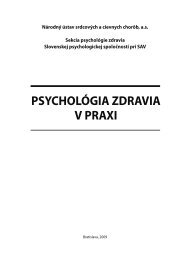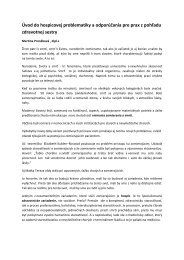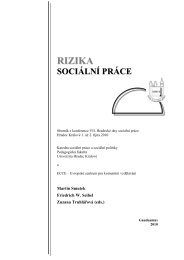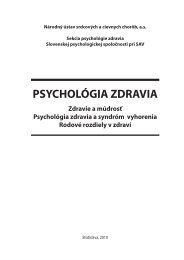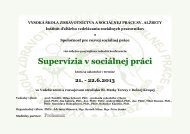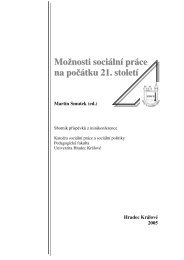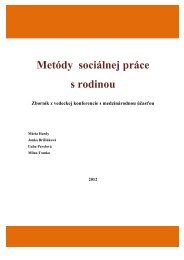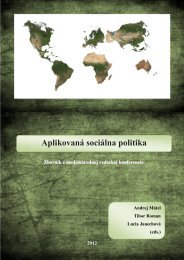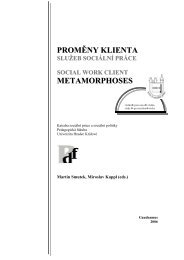Zmena klÃmy â možný dopad (nielen) na obyvateľstvo - Prohuman
Zmena klÃmy â možný dopad (nielen) na obyvateľstvo - Prohuman
Zmena klÃmy â možný dopad (nielen) na obyvateľstvo - Prohuman
You also want an ePaper? Increase the reach of your titles
YUMPU automatically turns print PDFs into web optimized ePapers that Google loves.
should follow an integrated approach, including major economic sectors such as<br />
transport, housing, energy and agriculture and also the promotion of education<br />
as a cross-cutting issue. A number of challenges for education are identified in<br />
mastering the transition to a green economy. Predomi<strong>na</strong>ntly, the need for green<br />
skills and for raising awareness is pointed out.<br />
It can be stated that the concepts of green economy and ESD are rooted in the<br />
same school of thought and serve the same goal and they are inherently interlinked:<br />
they both engage with the three interlinked pillars of economy, environment,<br />
society and environment and moreover with the relation between the local<br />
and the global and ultimately aim to foster sustai<strong>na</strong>ble development. Since ESD is<br />
able to change people’s mind towards valuing sustai<strong>na</strong>bility it represents the key<br />
pillar for implementing the green economy concept. The prerequisite for achieving<br />
a shift in economic thinking is learning about and understanding the concept<br />
of sustai<strong>na</strong>ble development, as well as the link between the multiple global crises<br />
and unsustai<strong>na</strong>ble economic activities. An integral framework can facilitate this<br />
understanding and awareness.<br />
However, while the ESD concept addresses explicitly all three pillars of sustai<strong>na</strong>ble<br />
development, the practical implementation of ESD in the UNECE region is still<br />
very much focused on the environmental pillar. The second <strong>na</strong>tio<strong>na</strong>l implementation<br />
reporting, conducted in 2010, showed that the environmental component of<br />
sustai<strong>na</strong>ble development still largely prevails. As in phase I of the implementation<br />
of the Strategy, the least attention is given to the economic component of sustai<strong>na</strong>ble<br />
development; in particular, little attention is given to the issues of corporate<br />
social responsibility and rural/urban development. According to the UNECE<br />
working document, embracing the economic component of ESD might prove to<br />
be necessary to foster the transition to a green economy in the region.<br />
A conceptual model, inherently linking all dimensions of sustai<strong>na</strong>ble development,<br />
connecting them to the moral economic (and societal) core, and explained<br />
through a series of successful, culturally embedded economic models – as the<br />
Integral Approach by Lessem and Shieffer does – could represent an effective<br />
learning tool in this respect. It could also help to upgrade the existing collections<br />
of good sustai<strong>na</strong>ble practices and learning materials to encompass all relevant<br />
dimension of social and economic innovation.<br />
In addition to the rich collection of economic models from various cultures,<br />
special emphasis should be given to local and regio<strong>na</strong>l good practices of integral<br />
approach. In 2009, The Slovenian project Solčavsko: Three Valleys in Unison<br />
won the title European Desti<strong>na</strong>tion of Excellence, on the theme of tourism and<br />
protected areas in Slovenia. It is distinguished by holistic, integral approach to<br />
142




